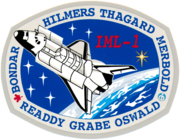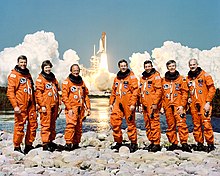 Spacelab Module LM2 in Discovery's payload bay, serving as the International Microgravity Laboratory (IML). | |
| Names | Space Transportation System-42 |
|---|---|
| Mission type | International Microgravity Laboratory-1 |
| Operator | NASA |
| COSPAR ID | 1992-002A |
| SATCAT no. | 21846 |
| Mission duration | 8 days, 1 hour, 14 minutes, 44 seconds |
| Distance travelled | 4,701,140 km (2,921,150 mi) |
| Orbits completed | 129 |
| Spacecraft properties | |
| Spacecraft | Space Shuttle Discovery |
| Launch mass | 110,400 kg (243,400 lb) |
| Landing mass | 98,924 kg (218,090 lb) [1] |
| Payload mass | 13,066 kg (28,806 lb) |
| Crew | |
| Crew size | 7 |
| Members | |
| Start of mission | |
| Launch date | January 22, 1992, 14:52:33 UTC (9:52:33 am EDT) |
| Launch site | Kennedy, LC-39A |
| Contractor | Rockwell International |
| End of mission | |
| Landing date | January 30, 1992, 16:07:17 UTC (8:07:17 am PDT) |
| Landing site | Edwards, Runway 22 |
| Orbital parameters | |
| Reference system | Geocentric orbit |
| Regime | Low Earth orbit |
| Perigee altitude | 291 km (181 mi) |
| Apogee altitude | 307 km (191 mi) |
| Inclination | 57.00° |
| Period | 90.50 minutes |
 STS-42 mission patch  From left: Oswald, Bondar, Thagard, Grabe, Hilmers, Merbold and Readdy | |
STS-42 was a NASA Space Shuttle Discovery mission with the Spacelab module. Liftoff was originally scheduled for 8:45 EST (13:45 UTC) on January 22, 1992, but the launch was delayed due to weather constraints. Discovery successfully lifted off an hour later at 9:52:33 EST (14:52:33 UTC) on her 14th flight.[1] The main goal of the mission was to study the effects of microgravity on a variety of organisms. The shuttle landed at 8:07:17 PST (16:07:17 UTC) on January 30, 1992, on Runway 22, Edwards Air Force Base, California.[1] STS-42 was the first of two flights in 1992 of Discovery, the second of which occurred during STS-53, which launched on December 2, 1992. The mission was also the last mission of the Space Shuttle Discovery to have a seven-member crew until STS-82, which was launched on February 11, 1997.
- ^ a b c "STS-42" (PDF). NASA. September 2011. Retrieved February 8, 2022.
 This article incorporates text from this source, which is in the public domain.
This article incorporates text from this source, which is in the public domain.